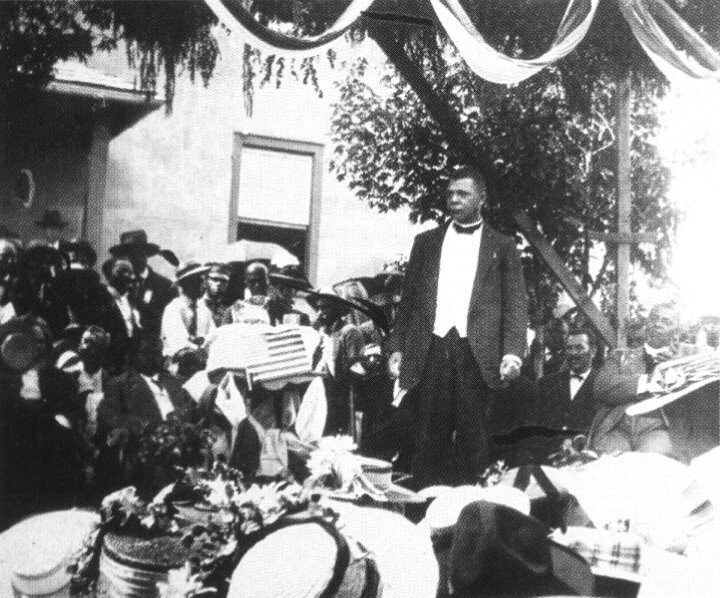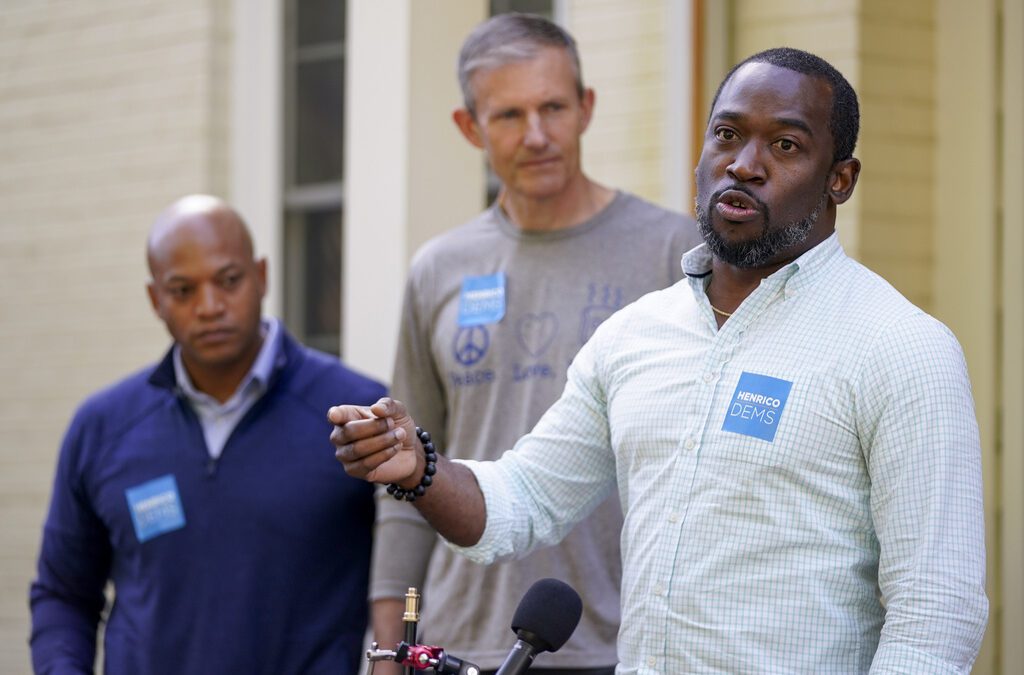
Booker T. Washington spoke in Christiansburg to a gathering of almost 5,000 locals in 1909. Photo courtesy of Christiansburg Institute Inc.
A school with a century-long history nearly faded into the past, but one passionate group won’t let that happen.
CHRISTIANSBURG – If you’ve never heard of Christiansburg Institute, you’re not alone. However, one local group hopes to change that.
The first southwestern Virginia school educating formerly enslaved African Americans resides in Christiansburg. While it had a century-long run, and even welcomed advisor Booker T. Washington to its campus, the institution’s story faded in fewer years than it operated.
Even executive director of Christiansburg Institute, Inc., Chris Sanchez, hadn’t heard of the school until years after he moved to the area in the early 2010s.
“I moved to Virginia about seven or eight years ago. I moved here to do youth ministry and be a part of church planting, launching a new church in Blacksburg,” Sanchez said. “We can fast-forward about five years later. A friend of mine, who is an organizer locally in Montgomery County and across the [New River Valley], he said, ‘Hey Chris, Christiansburg Institute is hiring a community organizer, would you be interested?’ I had no idea what CI was at that point. I had lived here for five or six years at that point and I did not know what CI was.”
The discovery moment
With his curiosity piqued, Sanchez and his spouse drove out to the historic property and had a look around. There, they saw buildings that weren’t in the best shape, far less land than what originally belonged to the school and a single monument displaying information about the campus. Still, the power they felt standing on the side of the road made an impact.
“I was just blown away immediately,” Sanchez said. “I’m talking, like, I didn’t even go inside the museum. I didn’t get to go inside the [Edgar A.] Long building. I’m just standing on the side of the street with my wife and we’re just looking at the land.”
Sanchez didn’t hesitate. He quickly applied for the organizer position, which he landed in 2017. Sanchez became the nonprofit organization’s executive director in 2019.
Before propelling CI into the 21st century, Sanchez first delved into the school’s past. That’s where he found Debbie Sherman-Lee, chair of the Christiansburg Institute, Inc. Board.
“I was able to go there my eighth grade year, which was the last year that the Christiansburg Institute was open, in 1965-1966,” Sherman-Lee said.
Sanchez noted that the presence of all age representations is one of the driving forces behind the present incorporation.
“We are very intergenerational in the work that we do as a nonprofit on a grassroots level,” Sanchez said. “So as often as we can have young people with the alumni in an intergenerational setting to preserve the history is, like, what we’re all about.”
A look in the past
Cpt. Charles Schaeffer, a Union soldier and Baptist minister from Philadelphia, Pennsylvania, founded CI shortly after the Civil War. In 1866, he taught 12 former slaves – an illegal act just one year prior.
“CI was the educational response to how do we educate, how do we empower black folks in this new Reconstruction world across the South?” Sanchez said.
Merely three years later, the Hill School, as locals called it, educated over 200 students.
In 1870, the Friends’ Freedmen’s Association helped Schaeffer fund the school. In the 1880s, Schaeffer turned over control of the school to a completely African American staff. He retired to focus on ministry, organizing 29 southwestern Virginia churches, before his death in 1899.
The institute experienced a major change three years before Schaeffer died. Booker T. Washington, founder of Tuskegee Institute, became CI’s advisor in 1896. In 1909, Washington addressed nearly 5,000 Christiansburg residents, both black and white. The Christiansburg Institute implemented a curriculum similar to those at Tuskegee and Hampton Institutes, and experienced growth during the first half of the 20th century.
In its time of educational growth, the campus also expanded. In 1927, CI opened the Edgar A. Long Building, named for the principal of the school from 1906-1924.
In 1947, the Friends’ Freedmen’s Association deeded CI to the Montgomery County, Radford and Pulaski County school systems. During the height of segregation, CI taught African American students from 15 counties at a time.
“Blacks weren’t allowed to be in school with whites,” Sherman-Lee said. “We had to have a place where we could go to learn and Christiansburg Institute was the place.”
As segregation ended and integration pressed forward, the school, open for 100 years, closed its doors.

Erasing history
“With desegregation, the schools closed,” Sherman-Lee said. “Any black school around the nation closed.”
With the closure of CI and so many other schools across the country, a part of educational history faded into oblivion.
“It’s a great question because it demands an answer. How does a 100-year institution that was nearly 200 acres, with approximately 14 buildings, why does it close down?” Sanchez said. “We know that desegregation was clearly a part of that, but so was the devaluing of black business and black culture and black history.”
Developers purchased much of the 185-acre campus, which sold at public auction. On the land, many residential neighborhoods, an industrial complex and harrowingly, a garbage dump, arose in the following years.
The development left some with connections to the school and its property feeling troubled.
“We talk about valuing land and we talk about valuing history and the land connected to that history,” Sanchez said.
In 1976, a group of passionate CI advocates formed. Together, Elaine Dowe Carter, Jacqueline Eaves and Gladys Sokolow in addition to many former students, fought to preserve the history through an alumni association that met annually.
“In 1996, roughly, the Edgar A. Long building and 4.4 acres of original campus property was actually donated to the alumni association by one of the property developers who had acquired the land,” Sanchez said.
With the gift of land and the historic building, the alumni association formed a proper nonprofit organization, Christiansburg Institute, Inc.
The renovations begin
“We are tasked with the historic preservation, restoration, fundraising, storytelling, sort of stewarding the mantle of CI into the 2020 new world,” Sanchez said. “That’s what we do.”
One of those responsibilities focuses on preserving a 93-year-old building on the property.
“We’re actively involved in restoring the Edgar A. Long building. That’s a continuation of decades of work from both the alumni association and CI, Inc.,” Sanchez said. “We just finished phase one of the Edgar A. Long building in this current year, which was to focus on the roof system and make the building weather tight. We’ve got a fully restored roof system, both internally and externally, a brand new sub-attic floor. We’ve preserved the roof line of the building to match its historic appearance. So when you look at the building today, it looks just like it was built in 1927 and we’re really proud to say that.”
The Edgar A. Long building – and its prior deterioration – isn’t only significant to CI. It’s part of a broader narrative in America’s history.
Out of the over 90,000 sites listed on the National Register of Historic Places, only two to three percent encompass non-white, non-European historical properties.
“What we’re seeing here in Montgomery County with the near total erasure of CI is also something happening on the national level with black history, period. There has just been a colossal failure to meaningfully preserve black historical sites, whether it be a cemetery or a neighborhood or an academic building like the Edgar A. Long building,” Sanchez said. “What we’re experiencing here on the grassroots level is indicative of a larger systemic problem, with black organizations really out to preserve black history.”

A new narrative
Even locals who haven’t left Christiansburg for longer than a vacation are just now discovering the school’s story.
“It’s actually pretty common for Debbie and I or other folks on our team to be giving a tour of the Long building or of the CI campus and folks are like, ‘I’ve lived here my whole life and I did not know about this history,’” Sanchez said.
That’s a conversation Sanchez and his team hope to change.
“A lot of people today still don’t know about this history. I think there’s lots of reasons why. I think just the valuing of non-white, non-European history in this country, we’ve missed the mark there tremendously. So I think there are some institutional factors that create the picture of not knowing about these remarkable histories. And there’s a tremendous amount of power in who does the telling of history, who gets to share the narrative and who gets to curate the story,” Sanchez said. “I would argue that this might be one of, one of, one of the first times where CI has had that institutional power to really articulate the narrative on behalf of CI. And that’s extremely important to what we do as a grassroots nonprofit.”
A community coming together
As CI continues spreading the word about its 100-year legacy, there are ways the community can help.
“The first thing that I always tell people that they can do is donate. I understand that lots of nonprofits have needs, resource needs. We have those same needs, but we also have a multi-million dollar historic preservation project of the Edgar A. Long building,” Sanchez said. “So when folks are kind of looking into the community and looking across the nation and we’re seeing this robust discussion about racism and antiracism and dismantling white supremacy, well, what can people do? People can fix their attention – whether that be resources or energy or time – on restoring the institute. This is in the heart of Montgomery County. It’s in the backyard of Christiansburg, which is the county seat of Montgomery County, and the school educated generations of African Americans from across the state and beyond for a century.”
Sherman-Lee added that following CI’s story through the nonprofit’s website or social media pages also helps spread the word.
For those interested in learning more about CI, the school’s history or the preservation work taking place on the site, reach out to the team at [email protected]
Amie Knowles reports for The Dogwood. She can be reached at [email protected]
Politics

Democratic shakeup in Virginia primaries for governor, lieutenant governor
Richmond Mayor Levar Stoney quit his bid for governor and jumped into the race to be the Democratic nominee for lieutenant governor. The race for...

New Biden rule protects privacy of women seeking abortions
Under the new rules, state officials and law enforcement cannot obtain medical records related to lawful reproductive health care with the goal of...
Local News

Virginia verses: Celebrating 5 poetic icons for National Poetry Month
There’s no shortage of great writers when it comes to our commonwealth. From the haunting verses of Edgar Allan Poe, who found solace in Richmond's...

Join the fun: Recapping Family Literacy Night’s storybook adventures
When’s the last time you read a book aloud with a loved one? If it’s difficult to answer that question, then maybe it’s time to dust off that TBR...





